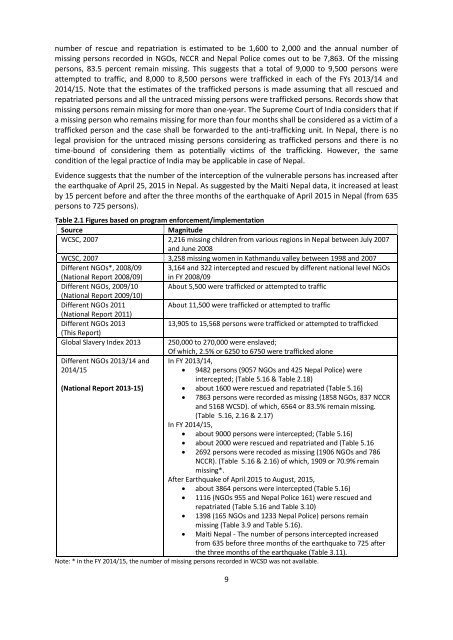TRAFFICKING IN PERSONS
1Spfyta
1Spfyta
Create successful ePaper yourself
Turn your PDF publications into a flip-book with our unique Google optimized e-Paper software.
Table 2.3 Number of Trafficking survivors as reported by <strong>IN</strong>SEC 2014<br />
Districts<br />
Number of<br />
district<br />
Number of<br />
survivors per<br />
district<br />
Total number<br />
of survivors<br />
Kathmandu 1 17 17<br />
Kapilbastu 1 15 15<br />
Bardiya 1 14 14<br />
Kaski 1 13 13<br />
Morang 1 12 12<br />
Nawalparasi and Sindhupalchok 2 7 14<br />
Kanchanpur 1 6 6<br />
Banke, Chitawan, Illam, Lalitapur, Mahottari,<br />
11 2 22<br />
Nuwakot, Panchathar, Parsa, Rautahat, Salyan and<br />
Sunsari<br />
Baglung, Bhaktapur, Darchula, Doti, Jhapa, Parbat,<br />
9 1 9<br />
Shankuwasava, Saptari and Siraha<br />
Total 28 122<br />
Source: <strong>IN</strong>SEC, 2014.<br />
2.3.2 Characterizing the Trafficked Survivors<br />
Who are the victims of trafficking? Here, this is evaluated from three sources (Table 2.4). One, the<br />
number of participants of a national conference organized by Shakti Samuha held June 4 and 5, 2014<br />
in Lalitapur, Nepal. Altogether 350 participants including 191 women trafficked survivors<br />
participated in the conference. Two, the number of cases of Human Trafficking disposed by the<br />
Supreme Court of Nepal in between 2007 to 2012. A total of 120 cases were studied by the National<br />
Judicial Academy (NJA). Three, the number of trafficking victims/survivors recorded in the Nepal<br />
police in the FY 2013/14 and 2014/15.<br />
The trafficked survivors originated across the country as indicated by the conference participants of<br />
Shakti Samuha. Majority originated from central development region (59%), followed by midwestern<br />
(18%) and eastern development region (17%). Nearly one-tenth of the conference’s<br />
participants were children (< 18 years of age). Data from the Supreme Court judgment revealed that<br />
only one-third of the survivors age was stated in the judgments (29% were under 20 years and 4<br />
percent were 20 years and above).<br />
Of the total 191 conference participants, 56 percent, 21 percent and 20 percent were Janajati, Dalit<br />
and other caste/ethnic groups, respectively. From the Shakti Samuha data, it appears that two<br />
disadvantaged social groups i.e. Janajati and Dalit - are overwhelmingly represented as the<br />
trafficking survivors’ vis-à-vis their share of population in Nepal. According to Population Census<br />
2011, Hill Janajati and Dalit constitute around 37 percent and 14 percent of the total population,<br />
respectively. Data from the Supreme Court judgment do not match with Shakti Samuha’s data. Yet<br />
majority of trafficked survivors comprised of Janajati (37%), followed by<br />
Brahaman/Chhetri/Dasanami (32%) and Dalit (16%).<br />
11


